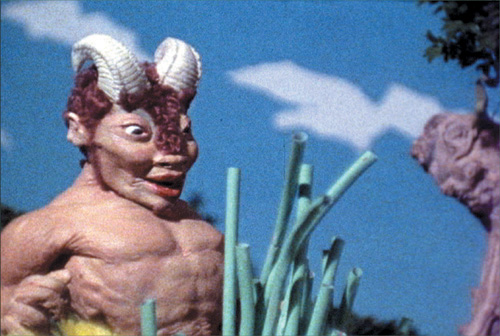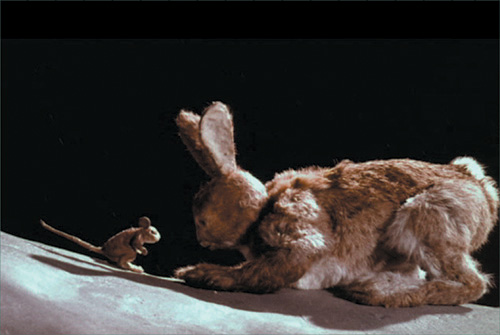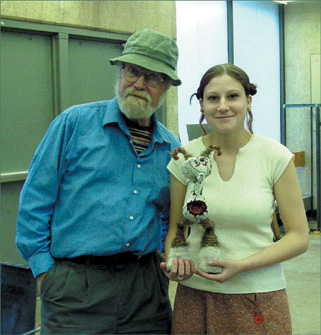Larry Larson (see Figure 10.1) has been involved in stop-motion for nearly 35 years, and he currently teaches character animation and puppet building at the Center for Creative Studies (CCS) in Detroit, Michigan. Larry was referred to me by my friend and animation mentor Steve Stanchfield, who also teaches at CCS.
KEN: Please give me a brief bio of your career in stop-motion and how you got started.
LARRY: The first stop-motion film I saw that changed my life was Lou Bunin’s version of Alice in Wonderland, which was on television one Christmas. Before that, I saw the odd George Pal Puppetoon in grade school, which they would show on 16mm film, and that was always fun to see, but I always was fascinated with how these things were done, because I could see they were real objects. Then when I saw The Seventh Voyage of Sinbad, I was at a very impressionable age, about 12 or 13, so then I knew that this was what I wanted to do. Then there were years of working at it and doing things wrong, without much guidance, because there wasn’t much information out there. Occasionally you’d see the odd image in a magazine and you’d say, “Ah, so that’s how they built it.” I made some films, but they weren’t story films, because I was so busy figuring out how to do this stuff. My first film with a story was Pipes of Pan (see Figure 10.2), which I made at Wayne State University here in 1972. I entered it into a Dallas Fantasy Film festival, and it won first place. I got some money for it, and it aired on public television. In 1973, I moved to Hollywood to find work and ended up getting hired to come back to Detroit! So I came back and worked on Barrington Bunny (see Figure 10.3), a short Christmas film where I built puppets and had my name all over it. One of my proudest moments was to have it screen along with a Peter Sellers film, The Optimists of Nine Elms.
I then got to work with Bob and Dennis Skotak before they became successful in the visual effects industry, on an unrealized film called Timespace, for which I built puppets and helped with process photography and composites. I continued working on short films and features, continuing to use the process projector I had built for projects like Epic of Gilgamesh. I did an animation of a local iconic statue called the Spirit of Detroit, which ran for about 15 years on television. I got paid for it, too, which was good. It’s important for a filmmaker to start that interchange early on, even if it’s not that much. If you start doing that, people will continue to pay you, and I was lucky enough to be paid for my own projects and have them run. So I did a few more commercials for Tubby’s Submarines, Ameritech, car dealerships, and other businesses. In 1987, I went down to North Carolina and worked on Evil Dead 2, which was a terrific experience, working with folks like Tom Sullivan and Rick Catizone. I was hired to help make the stop-motion production work well. Years later, I worked on The Carrier, another low-budget film, and Flesh Gordon 2, for which I built and animated rubber monsters. In 1992, I got to work as director of cinematography on a film called That Special Gift, which was a great experience working with lighting real people after only lighting puppets for so long. In 1999, I picked up a Silicon Graphics workstation and learned the software package Maya, only to learn I really liked working with puppets better than computers. I got to create a CG car for the auto show, and in the meantime having oil painting shows and classes, and doing animation for local poets. Then in 2001, I became a character animation instructor at CCS, which gave me a place to put to use the knowledge I had picked up over the years and help some young people in a way that I didn’t get helped at that age. Since then, I’ve made things like gophers and singing vacuum cleaners for various productions, and continue with teaching and oil painting. I like organic media, and I’m basically in the business of making things for people that work.
KEN: Out of this entire body of work, which project are you most proud of?
LARRY: Oddly enough, I like my early work the best. I know most artists would say they like their later work, but I really enjoy Pipes of Pan, Barrington Bunny, even the Timespace project, for their youthful energy and where they fell in the industry at the time. They had a lot of heart and contained more of what I think puppet animation is about. I found a print of Barrington Bunny in an old theater here, and the projectionist ran it every Christmas for the kids, just because he liked it. [laughs] And that means more to me than just doing jobs to order. They’re fun, they pay the bills, I learn things, and meet great people, but it’s not as engaging as things that come from your heart. Artists should be able to make projects that say something, too.
KEN: How else are commercials different from films?
LARRY: Well, they both have extreme time constraints, but there’s a little more freedom on feature films, because they will usually let you do something again if you don’t get it right. With commercials, they are willing to trade lots of money to save a little time, so that doesn’t leave a lot of time for re-dos, so you don’t learn as much. It’s more like, “Here’s the product. Give me the money.” Films have a much more creative atmosphere, because the director has a vision, and it’s your job to find that vision and add your bit to it. The best directors allow you to be a good artist. I’d rather work on films, although it’s hard because you often have to leave town, which was tough because I had a family at home. They had to come down to North Carolina to see me during Evil Dead 2. Lots of people have to travel all over the world to be in the places where the film is being done, but I’m more of a home guy. Commercials are usually done in your home town, because there’s no time to go anywhere!
KEN: Especially with stop-motion, you would have to be on set, since it’s not like Flash or CGI work that you can just send by e-mail, right?
LARRY: Right. Plus, if they’re spending that much money on you, they want you to be there so they can look over your shoulder and buy you lunch! But now, with the advent of little production companies making big films far from Hollywood, you can make a film with your talent pool spread out over a larger geographic area. For economic reasons, that might make sense, and could become a big trend.
KEN: Tell me a bit more about your current teaching position.
LARRY: Well, I’m teaching short courses for character animation in Maya and also in stop-motion, never the same way twice, because nothing’s ever perfect. One time in class we focused on building wire armatures and cast rubber figures. Ray Harryhausen, who I know quite well, visited us once (see Figure 10.4).
He favors the ball-and-socket armatures over wires, and when he got here I was teaching ball-and-socket construction and the machining skills needed to make armatures. Many students got to go through the whole process and create finished puppets, which I was very proud of. Just recently I taught about 12 to 15 students—very talented young people—how to animate using surface gauges and learning the importance of tie-downs. We’re using a Lunchbox frame-grabbing system, and hopefully will start using a computer software to give us more options. I have my students make a film that is totally from them, so they have that chance to make that personal statement right away, because I think that’s important. If I were able to develop an even more complete course in stop-motion, it would be at least a two-year course. Students would build their own puppets and make their films but would also learn the language of cinema, lighting, construction techniques, animation, and compositing, which the computer does well. But the considerations would still be the same as they would for an oil painter, like saturation and composition—all the creative decisions that can’t be built into a software program. In both mediums, CG and stop-motion, the animation principles are the same, too; it’s all about physics and acting. There are people who devote their whole lives to just being actors; it’s a noble art. So you add that to the other skills needed to make a stop-motion film, and it’s a daunting list of what’s necessary: lighting, lenses, exposure, color correction, puppet animation, storyboarding, clay modeling, mold making, casting, plastic, foam rubber, brazing, welding, glazing, matte painting, stage construction, urethane molding (dense and light, soft and rigid), silicone, polyester, vacuum forming, plaster...and this is just a short list of things I’ve learned how to do.
KEN: What’s the usual format for your classes and the way they are taught?
LARRY: The only way I teach is by giving short lectures and inspirational pep talks to the whole class, and then I work individually with each student. [The students have] their own needs and their own way of learning, and I have to figure out who they are and how to get it to them. We have four stations in the stop-motion lab, and I have to run around really fast to each of them...I work really hard! [laughs] What’s great now is that students can shoot animation with a digital camera themselves and own their own work, so they could do the animation at home and bring it in for critiques. This trend will continue, because people can now express themselves in this wonderful medium without buying $7,000 cameras. One of my students wants to go to Ireland to teach people how to make puppet films! So I say, yes! I want to support that, because he’s a good student, and people need to know that stop-motion is accessible. It’s a real art, and that’s important.
KEN: What are the main differences you see between the CG and stop-motion mediums?
LARRY: The computer is a magnificent engineering accomplishment, and I respect it, but the computer only gives you back what you put in. You’ve got to know a thousand times as much as your audience to get all that other information in there. Whereas when you work with organic media, the media itself helps you. It helps you by fighting back, like when rubber or clay doesn’t work the way you want it to, and half the time, that’s good. To me, that introduces a little bit of humility into the artistic process. When the computer only gives back what you give, it gets to be a big limitation, because very few people know what to give the computer to get back what they want! I once saw a real scientific study where they tested a guy whose plumbing between his right eye and conscious brain was damaged in an accident; the eye and brain were both fine, but there was no connection. And they discovered through magnetic resonance imaging that there are six more pathways into the human brain that are not conscious. So that means that left-brain thinking, the conscious intellectual information, is only the tip of a very large iceberg. The other part of the brain is where the art is, so how can you put all of that information into a computer without assistance from the wonderful infinite universe and all its variations? [laughs] The limitations with computers are really with the operators, the human beings. You have to import this whole world into the computer, so if you can’t draw or sculpt, what are you going to do with it? We’ve had many years of computer animation films now, and audiences don’t really know what they are seeing. Stop-motion has a very important quality about it, because it partakes of this world. It’s got a beauty and humility to it because it uses real materials, so I think it will continue and increase.
KEN: What’s the biggest change you have seen after nearly 35 years in this industry?
LARRY: Nothing significant; it’s the same game: artists with a vision working with businessmen making money. It’s the same thing it always was! [laughs] The problem has always been, how do you have a vision, maintain it, express it, and then make a living? A wise man once said, “Life is about learning how to live and how to make a living.” So we all face the same problem. If you’re gifted and burdened with a vision, and a passion to do this, how do you live in this world? That’s the task. In the industry, there will always be people who don’t understand what you’re doing, so you have to deal with them as best you can, collect your paycheck, and run the gauntlet. But you have to keep your original vision alive! I tell my students (see Figures 10.5 and 10.6), your big trick when you were little was to turn over, and then you learned how to walk, and so on. At some point in this little drama of life, you decided to make something good, so hold on to that moment in your life, when you decided to make something that you liked, and that maybe other people would like. If you can carry that same vision through your whole life and never lose it, you’ll have a pretty good life.






